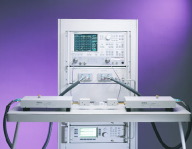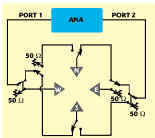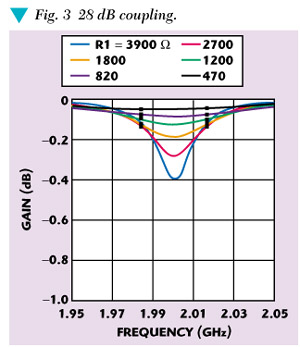A Broadband Bias Tee for Optical Networking Applications
Inmet Corp.
Ann Arbor, MI
 The explosive growth of the Internet has created an insatiable demand for communications bandwidth by everyone, from the Web-browsing individual in the home office, to the multibillion-dollar corporation that is at a severe competitive disadvantage without it. Although several broadband access methods are now available, fiber optics is still the primary vehicle for broadband connectivity, particularly for communications traffic over long distances. Even with the large number of fiber-optic links already in place, over 90 percent of the commercial buildings in the US are still not served. This market represents an enormous opportunity for optical networking system, module and component manufacturers, and is the reason for the unprecedented growth rates that are expected in this market segment, some of which have already started to take shape.
The explosive growth of the Internet has created an insatiable demand for communications bandwidth by everyone, from the Web-browsing individual in the home office, to the multibillion-dollar corporation that is at a severe competitive disadvantage without it. Although several broadband access methods are now available, fiber optics is still the primary vehicle for broadband connectivity, particularly for communications traffic over long distances. Even with the large number of fiber-optic links already in place, over 90 percent of the commercial buildings in the US are still not served. This market represents an enormous opportunity for optical networking system, module and component manufacturers, and is the reason for the unprecedented growth rates that are expected in this market segment, some of which have already started to take shape.
Fiber-optic technology has made tremendous progress in recent years with respect to bandwidth and data capacity to support this demand. Optical carrier (OC) systems have quickly evolved from 2.5 Gbps (OC-48) to 5 Gbps (OC-96), and now 10 Gbps (OC-192) systems have reached mass production levels, which, not too long ago, were thought to be impossible. However, the demand continues to explode. Internet traffic is growing at a rate of 200 percent per year and now exceeds the amount of voice traffic. In order to support the necessary data applications, 40 Gbps (OC-768) systems are already being developed and prototyped for use in several long-haul and transoceanic communications links.
However, 40 Gbps systems present entirely new challenges because the overall speed and performance of the components used in these systems must be effectively increased four times over existing 10 Gbps systems. In addition to the challenges associated with the optical components (such as laser diodes and photodetectors), unique challenges also exist with the RF/microwave components that are required to support these functions. Due to the non-return-to-zero (NRZ) modulation methods used in these systems and the high frequency performance needed to support the desired data rates, RF/microwave components must operate over an extremely broad frequency range. Examples of passive components that face this challenge are DC blocks and bias tees that utilize frequency-dependent components, such as capacitors and inductors.
The model 8810EF bias tee has been introduced in response to the increasing market demand for broadband RF/microwave components used in higher data rate optical networking applications. The 8810EF bias tee utilizes 2.4 mm connectors and is targeted to operate over the 100 kHz to 50 GHz frequency band. Since a low cost design approach was the focus from the beginning of product development, the 8810EF is priced very competitively and can consequently be used in the production of optical systems and modules, as well as for test and measurement applications.
Typical insertion loss and return loss performance of the 8810EF bias tee is shown in Figure 1, where the frequency is plotted on a log scale so that the low frequency performance is easier to distinguish. The graph shows that the insertion loss at 100 kHz is still less than 0.5 dB and the return loss is approximately 18 dB, equating to an SWR of 1.3. Figure 2 shows the insertion loss and return loss vs. a linear frequency range from 10 to 50 GHz. The 8810EF was designed to handle 250 mA of DC current so that it can be used to bias higher current components (such as transimpedance amplifiers) in addition to lower current components (such as optical modulators). A summary of the product's specifications is listed in Table 1.



Figure 3 shows the typical isolation performance of the bias tee between the DC and RF ports. The device typically exhibits better than 40 dB of isolation at the lower frequency range and equals or exceeds 30 dB over the entire 100 kHz to 50 GHz bandwidth.

Although the 8810EF bias tee consists of two female 2.4 mm connectors, other sex configurations are available (for example, male/female combinations). There are also plans to offer this bias tee with 2.9 mm connectors for 40 GHz applications, as well as with a variety of connectors used for injecting the DC bias. The model 8810EF uses an SMA connector for the DC bias; however, an SMC connector can also be provided in addition to the option of two terminals for voltage and ground. Additional information on broadband bias tees and other broadband components such as DC blocks, DC blocking terminations and attenuators can be obtained via e-mail from clindberg@inmetcorp.com.
Inmet Corp.,
Ann Arbor, MI (734) 426-5553.
